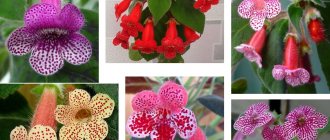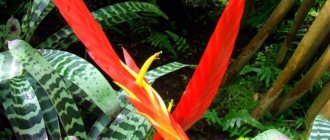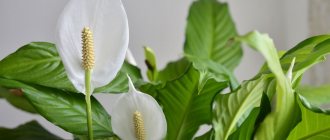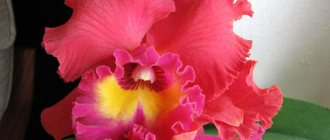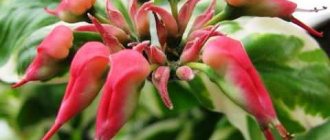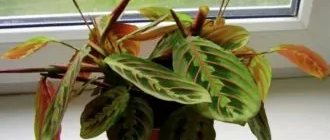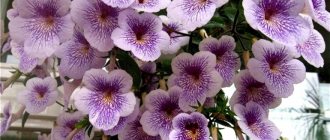Pilea is a herbaceous plant or shrub from the Nettle family. Unites about 400 species, can be either annual or perennial.
Homeland - Southeast Asia and Vietnam. Unpretentiousness, endurance, variety of species and varieties, luxury of small decorative foliage, ease of propagation - all this characterizes Pilea, which can be grown even by novice gardeners.
The height of the pilea reaches 35-45 cm. The intensity of its growth is very high: in one season, a plant grown from a cutting reaches the size of an adult. The stems of the flower are highly branched and can creep. Leaves with pronounced veins grow alternately on shortened petioles.
Depending on the type, they can be leathery and rough or miniature and smooth, velvety or glossy, have jagged or smooth edges. The color of the leaf blade varies from green and light green to brown and crimson, with multi-colored veins, stripes and spots.
Pilea blooms with small, inconspicuous flowers collected in racemose inflorescences.
| It grows very quickly. |
| It blooms very rarely in summer. |
| The plant is easy to grow. |
| Up to 4 years, then should be rejuvenated. |
Caring for Pilea at home. Briefly
| Temperature | In summer 19-23 degrees, in winter 15-17, but not lower than 10 degrees. |
| Air humidity | High. |
| Lighting | Pilea at home needs bright, diffused light; east or west window. |
| Watering | Moderate; in summer 2-3 times a week, in winter 1 time a week. |
| Priming | Medium fertile with a neutral or slightly acidic reaction, permeable to water. |
| Feeding and fertilizer | During the growing season, apply liquid complex fertilizer once every 2 weeks. |
| Transfer | Once a year, in spring in wide pots. |
| Reproduction | Stem cuttings. |
| Features of cultivation | Does not tolerate drafts well and needs pruning and pinching. |
Shade or sun? Optimal position for the Pilea
The best place to grow Pilea at home is in a fairly bright room that is not exposed to direct sunlight. Therefore, it is best to place the plant a few meters from the window (if you want it to decorate a room located on the south or west side of the house). Pilea can grow from both the east and the north, provided there is slight partial shade.
This heat-loving plant of tropical origin requires not only partial shade, but also warmth - it does not tolerate drafts . Therefore, it should be remembered that during ventilation, especially in winter, you should not expose it to gusts of cold air. In spring and summer it likes room temperature (20-25˚C), but in autumn and winter it can be adapted to a room with a slightly lower temperature - 15-18˚C.
Caring for Pilea at home. Details
Pilea care at home does not require too much care. She doesn't notice occasional mistakes, but she won't forgive serious mistakes. Therefore, in order to enjoy the lush decorative foliage as much as possible, it is important to create suitable conditions for it.
Bloom
In apartment conditions, Pilea blooms extremely rarely.
Usually buds appear in summer. Inconspicuous monochromatic flowers are collected in racemose inflorescences in the axils of the leaves. They have no decorative value.
Temperature
The maximum temperature for Pilea is 25 degrees, the minimum is 10 degrees. The optimal thermometer readings in summer are 19-23 degrees, in winter 15-17 degrees. If it is not possible to organize a cool winter, it is important to take care of good lighting at this time.
Pilea is afraid of drafts and sudden temperature changes - this can lead to the death of the flower. The pot with the plant should be located away from the windows and the door to the balcony.
Spraying Pilea
Pilea at home prefers high environmental humidity.
However, it is not recommended to spray it, especially species with velvet foliage. Spots may remain on the leaves, they lose their decorative appearance, wither or dry out. To increase air humidity, you can take the following measures:
- Use a humidifier;
- Place the pot in a tray with damp pebbles, moss or expanded clay. In this case, the bottom of the pot should not touch the water;
- Place a container of water near the plant: as it evaporates, it will increase the humidity.
Lighting
For the full development of the Pilea, bright, diffused light is required.
The optimal place is an eastern or western window sill. On the south side, the plant will need shading using a translucent curtain. Or the pot can be placed on the nightstand near the south window. Otherwise, direct rays of the sun may cause burns on the leaves. In winter, due to lack of light, variegated varieties may lose the brightness of their leaves and their stems may become elongated. With short daylight hours, the plant can be moved to a southern windowsill. It would not be superfluous to additionally illuminate the flower with phyto- or fluorescent lamps for 8-12 hours.
Watering
Pilea needs regular moderate watering in spring and summer (2 times a week) and rare (once every 7-10 days) in winter.
Between moistenings, the top layer of soil should dry out a little. If we talk about extremes, the pilea tolerates drought better than waterlogging. The latter is fraught with withering and fading of the leaves, and rotting of the roots. The plant responds better to frequent but meager watering than to rare and abundant watering.
Water for irrigation should be left to settle for several days; it should be at room temperature.
Pilea pot
Since Pilea has a shallow root system, the pot should be shallow (no higher than 10 cm) and wide. Unusual flowerpots or decorative trays will do.
The pot must match the size of the plant. If you choose a pot that is too large, the likelihood of soil acidification and rotting of the root system increases.
Soil for Pilea
Pilea grows well in fertile, loose soil with medium or weak acidity (5.5-6 pH). A store-bought substrate for decorative foliage plants is suitable. If you have the opportunity to prepare the mixture yourself, you can choose one of the options:
- leaf soil, humus, peat and sand in a ratio of 2:2:1:1;
- greenhouse soil, peat and perlite in equal parts;
- turf soil, leaf soil, peat, sand, expanded clay (1:1:1:1:1/2).
Before planting, it is recommended to disinfect the prepared mixture by spilling it with a weak pink solution of potassium permanganate.
Homemade Pilea also grows well in hydroponics.
Feeding and fertilizer
Due to a lack of nutrients, Pilea slows down its growth, and its leaves become smaller and lose their decorative properties.
It is recommended to fertilize throughout the year: in spring and summer – once every 10-15 days, in winter – once a month. Complex liquid fertilizers for decorative foliage plants are suitable. Concentration - according to instructions.
Fertilizers should be applied after watering to moist soil so as not to burn the root system.
Pilea transplant
The optimal time for transplantation is from early spring to mid-summer. Plants are replanted once a year.
If necessary, the bushes are divided. To maintain a decorative appearance and compactness, the pilea is cut off before transplanting, and the tips of the shoots are pinched. When transplanting, it is important to lay a 3-centimeter layer of drainage at the bottom of the pot. Crushed brick, expanded clay or pebbles are suitable for this purpose.
Pilea quickly degenerates: it stretches out, loses its compactness, and the stems become exposed. Therefore, it is recommended to update it by cuttings. Some perform the procedure annually, others once every 2-3 years. The reference point is the appearance of the plant: if it has lost its attractiveness, rejuvenation is necessary.
Trimming
Since the Pilea flower at home grows quickly and branches heavily, it requires annual pruning. The procedure is optimally carried out at the beginning or end of the growing season (beginning of spring or autumn).
To make the plant lush and compact in size, the tops of the shoots are regularly pinched. The cuttings remaining after pruning can be used to propagate the flower.
Rest period
Pilea does not have a clearly defined dormant period. Like most indoor flowers in winter (from November to February) it stops growth and development. Does not require special care during this period.
Transfer
Pilea Cadieux - care and propagation at home
The transplant procedure is recommended to be carried out annually. The optimal time for this is the second half of spring or early summer. Since Pilea has a small root system, shallow pots 10-12 cm high are suitable for planting it.
Pilea transplant procedure
During replanting, pruning can also be done. It consists of shortening the shoots by 30%. If a plant loses its decorative appearance, it is completely rejuvenated.
Pilea propagation
When propagated at home, Pilea is propagated by cuttings.
The procedure can be carried out throughout the year, but the optimal time is spring: the pilea takes root faster and grows with young shoots.
Cuttings 7-10 cm long with 2-3 pairs of leaves are suitable for propagation. They should be planted in sand or adult plant substrate and covered with polyethylene or glass. The “greenhouse” is placed in a warm place, protected from direct sunlight, regularly ventilated and watered. When the cuttings have taken root and new leaves have appeared, the polyethylene or glass is removed.
Freshly cut cuttings can be placed in water, and when they have roots, they can be planted in individual pots. You can plant 2-3 cuttings in one container - such a bush will be more lush.
Difficulties in growing
Flower growers often face the following problems:
- The leaves lose color and the tips begin to dry out due to lack of lighting.
- The stems are limp, the leaves wither and fall off when the substrate is too wet.
- The leaves dry out and wrinkle at high or low temperatures or prolonged drying of the soil.
- When exposed to direct sunlight, burns occur - brown or yellow spots.
- The shoots become bare, shed their leaves - it’s time to rejuvenate the plant.
Sunburn on plant leaves.
Pests
When the room temperature is too high and the humidity is low, the pilea is attacked by spider mites, thrips, and scale insects. Pests can be difficult to notice on small-leaved species. Infection becomes clear when traces of their vital activity are detected and the plant is depleted.
- When affected by spider mites, cobwebs are noticeable in the internodes, the leaves wither and fall off. The pilea is washed with a sponge soaked in a soapy solution, washed with warm water and sprayed regularly. In case of severe damage, use the Actellica solution - 1-2 ml per liter of water.
- Thrips appear at high temperatures and low humidity. Light dots appear on the upper side of the leaf, and colonies of pests are noticeable on the lower side. As a result, the upper part of the leaf acquires a silver-gray tint. To combat it, the pilea is repeatedly sprayed with insecticides (Fitoverm, Actellik).
- Scale leads to rapid drying out and falling of leaves, spoiling the appearance of the plant. Insecticides are also used to combat it.
Diseases and pests
Pilea is a fairly hardy plant. However, if the basic rules of caring for it are not followed, difficulties may arise. Here are the main problems and the reasons for their occurrence:
- The lower leaves of the Pilea fall off - incorrect watering regime (excess or lack of moisture).
- Pilea leaves turn black - the temperature is too low.
- Pilea leaves droop - insufficient watering.
- Pilea shoots are stretched - lack of sunlight.
- Drying spots appear on the leaves - these are burns due to direct rays of the sun hitting the plant.
- The lower parts of the branches become bare - the bush is degenerating and needs rejuvenation.
Among the pests, Pilea can be affected by aphids, scale insects, spider mites, and thrips.
Possible problems
If the Pilea is not properly cared for, then problems may begin with it:
- The foliage dries up and flies away . If the room is colder than 12 degrees or warmer than 27 degrees, then the leaf plates will wrinkle, dry out, and fly around. This can also happen due to drying out of the earthen coma.
- The leaves are withering . If liquid regularly stagnates in the substrate, this can cause limp foliage to appear; after a while it will turn black and fly off, and the shoots will become soft.
- The leaves are turning pale . Excessively intense lighting can cause foliage to become faded, limp and a little translucent. At the same time, its edge dries and turns brown. Due to excessively poor lighting, the edges of the leaf blades will also turn brown and dry out, while they themselves lose their spectacular color, and young leaves grow small, the stems become elongated.
- Spots on leaves . As a result of exposure of the bush to direct rays of the sun, sunburn may form on the foliage, looking like yellow spots, which eventually turn brown.
- Flying leaves . If only the lower leaf plates fly around, then this is quite normal and is associated with the aging of the plant. In this case, it is recommended to cut several cuttings from the bush and grow a young plant from them.
- Harmful insects . Thrips, mealybugs, spider mites and scale insects can settle on the pilea.
Types of Pilea domestica with photos and names
Pilea peperomioides
Forms a compact bush, up to 45 cm high. On a rigid stem, rounded leaves on long petioles are placed oppositely. The leaf blade, up to 7 cm in diameter, is smooth, green in color, and slightly bent inward.
Cadie's Pilea, Silver Pilea (Pilea cadierei)
A bushy plant, up to 40 cm high. Young stems are erect, mature stems lean towards the soil and branch strongly. The leaves have an elongated oval shape, up to 5 cm wide, up to 20 cm long. The green leaf plate with three veins has two silvery lines along it. Small flowers are collected in axillary inflorescences.
Pilea microphylla
Perennial herbaceous plant, up to 15 cm high. Arched light green shoots are highly branched. They have many miniature light green leaves, up to 0.5 cm long, placed opposite them. The leaf blade is glossy, oval or round in shape. In the axils of the leaves, tiny flowers, both unisexual and bisexual, are collected in corymbose inflorescences.
Pilea filamentous (Pilea numiralifolia)
An ampelous plant with thin reddish shoots. Small rounded leaves, up to 1 cm long, are alternately placed on them. The underside of the leaf plate is painted purple.
Pilea involucrata
A herbaceous plant with erect or creeping stems, up to 30 cm high. The opposite leaves are oval in shape and have pronounced serrated edges. Their length reaches 7 cm. The leaf plate is tuberous, light green in color, and brown in the area of 3 longitudinal veins. This species is used to create hybrids.
Description of the plant
“Pilea peperomiiformes” is a representative of a genus of more than four hundred species. Belongs to the nettle family. It originates from India and is also common in western China. It began growing indoors relatively recently, appearing in Europe in the forties of the last century.
The height of the plant is 30-40 cm. In the center of the bush there is a stem from which leaves hang on elongated petioles. The rounded leaves have a glossy surface. Sometimes it blooms with small red flowers, but this is only if the rules of winter care are followed.
“Pilea Peperomiiformes” is a rather unpretentious plant: drought- and cold-resistant.
Growing Pilea from Seeds
Pilea peperomioides from seeds photo of seedlings
Only some types of Pilea reproduce generatively. If you find seeds on sale, start sowing in the spring.
- Take cassettes for growing seedlings or any wide container, pour in a sand-peat mixture or universal soil, distribute the seeds over the surface, sprinkle with a thin layer of substrate and spray with a fine sprayer.
- Germinate seeds in greenhouse conditions: cover the top with glass or a transparent bag, maintain diffused lighting and temperature within 20-22 °C, raise the cover for a few minutes every day for ventilation, and spray the soil with a fine spray as it dries.
- Seeds germinate in about 1 month.
- After the shoots appear, accustom them to life without a wig gradually, since the sprouts are susceptible to dry air, water moderately.
- At the stage of the appearance of a pair of true leaves, we transfer them into separate pots with soil for adult plants.
